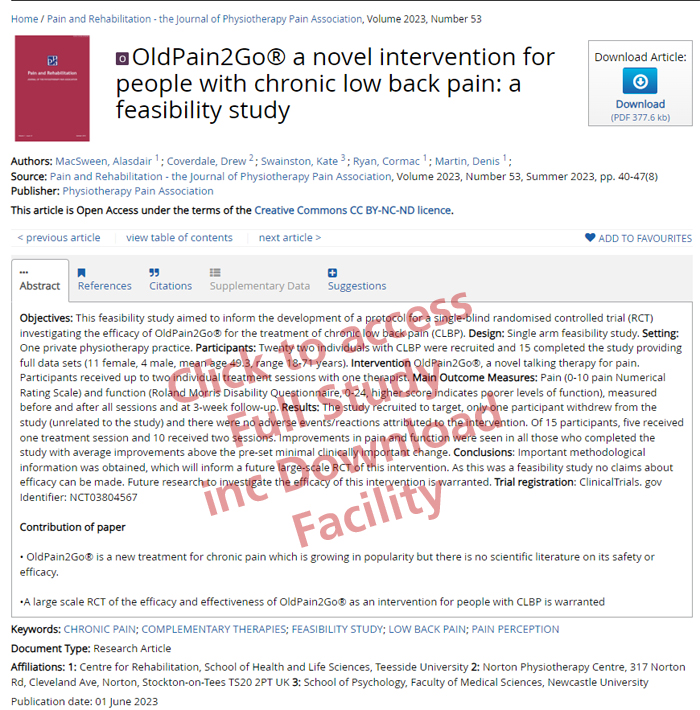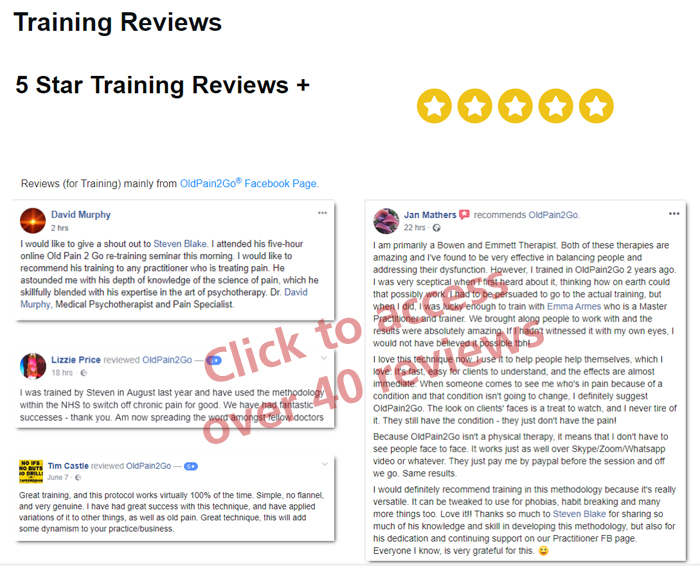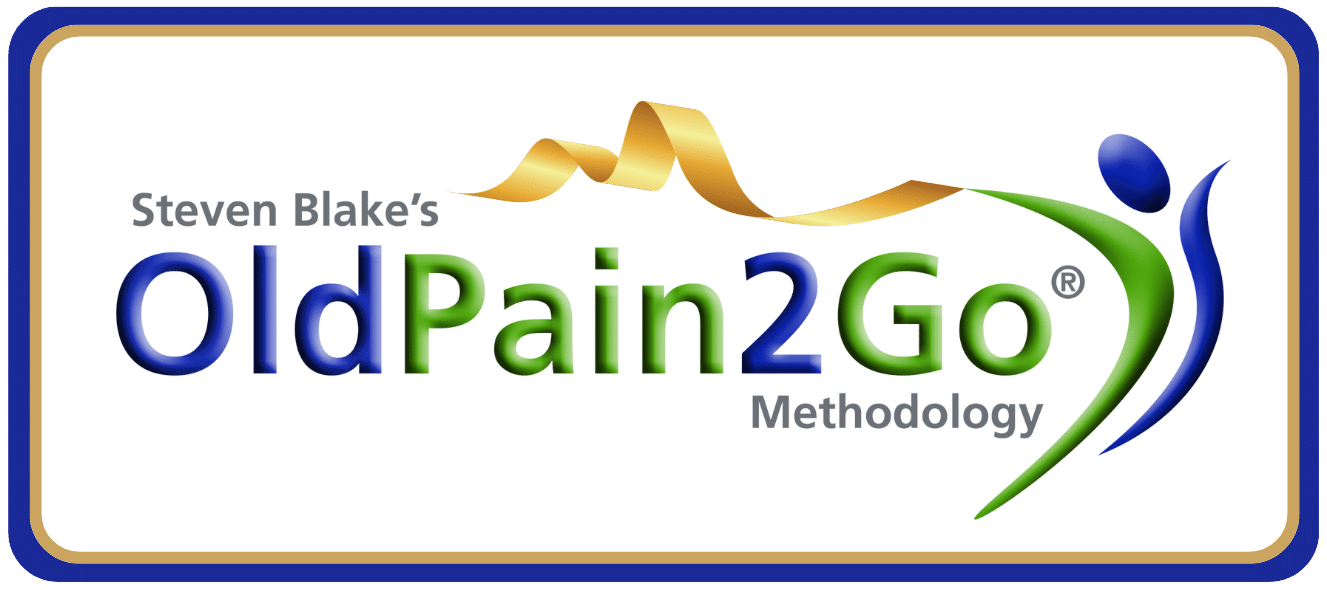OldPain2Go® A Wealth of Anecdotal Results
A page of assembled feedback, collected first hand, from those who had an OldPain2Go® treatment, for you to draw your own conclusions. Results are relevant only to each individual who is sharing their subjective experience.
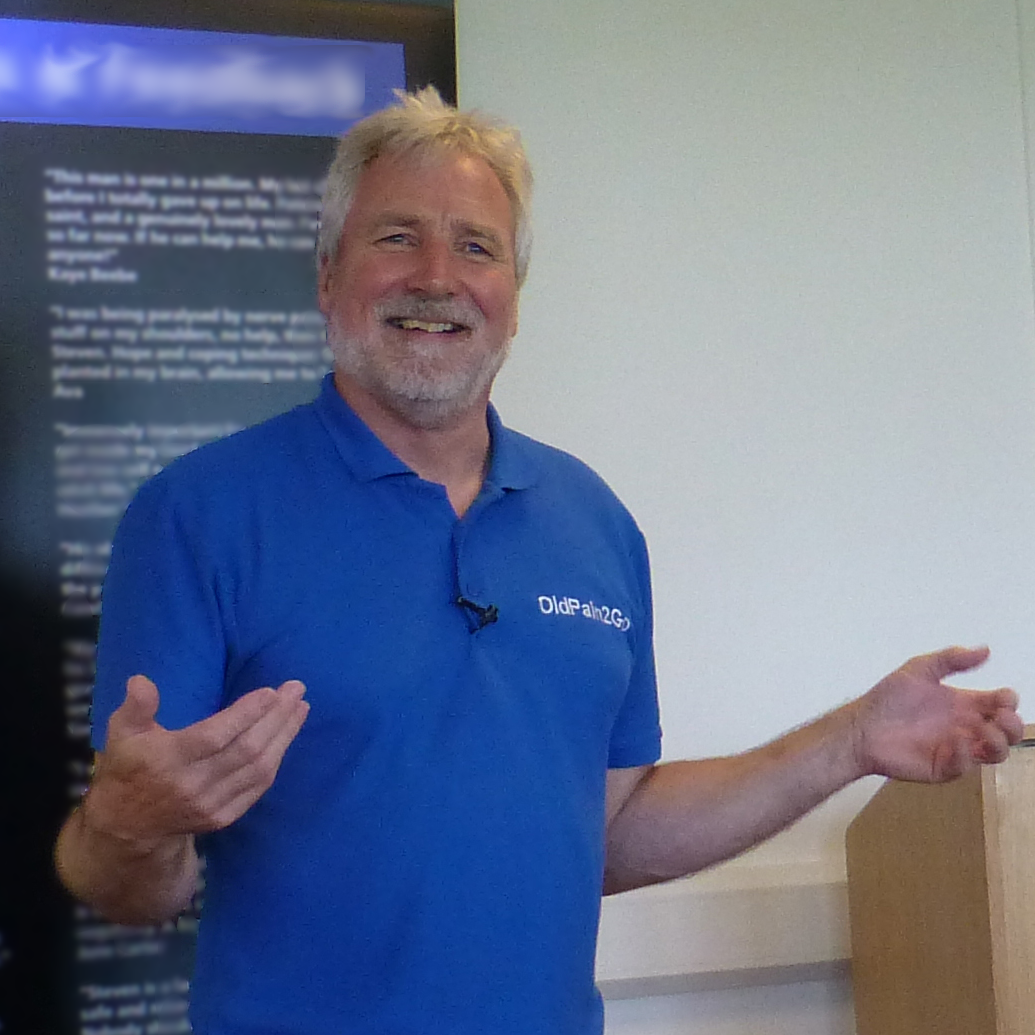
"All pain is real and all pain is a calculation in the brain to assess what level of pain is needed to protect you. Pain works by annoying you until you take appropriate action towards safety. When there is no action you can take, then the pain is no longer a message protecting you. To have the brain cease sending out old pain messages it simply requires a new understanding of the current situation and a reassessment of whether continuing that old pain message is helpful or harmful and what level of pain (if any) is best for survival and a good quality of life. There is no need for a long "cure" that will be hard work for the client. A "cure" isn't needed, just a reassessment of safety. Your brain will always do what is best for you based on all it knows, sometimes it just needs convincing that pain isn't the best option."
Steven Blake 2022
What is OldPain2Go?
OldPain2Go® presents a non-medical approach to address chronic pain by drawing upon the biopsychosocial model of pain. In this model, the underlying cause of persistent pain and its transition to chronicity is believed to extend beyond simple tissue damage, injury, or malfunction. Instead, the intervention focuses on subconscious communication to assist patients in reframing their chronic pain as non-threatening and eliminating outdated pain messages that no longer serve a purpose.
Unlike traditional methods, OldPain2Go® directly applies the concept of reframing and re-education to both the conscious and unconscious mind, without the need for inducing a trance state. This unique approach has garnered interest, with 1,671 individuals trained in the delivery of OldPain2Go®, including registered healthcare professionals such as doctors, physiotherapists, psychologists, neurologists, and nurses. Approximately 70% of these trained practitioners are based in the UK, while the remaining professionals hail mainly from Australia, USA, Canada, Netherlands, Norway, and Belgium.
The growing popularity of OldPain2Go® is primarily based on positive anecdotal evidence, as there are currently no published scientific studies investigating this innovative treatment. Considering the significant demand and rapid expansion of this approach, there is an urgent need for robust investigations into its safety and efficacy. Such research is crucial to inform clinical decision-making and empower patients with better choices for managing chronic pain.
It is essential for medical professionals to remain open to exploring new interventions that may provide relief and better outcomes for patients dealing with chronic pain. A comprehensive examination of OldPain2Go® will contribute to advancing the field of pain management and ultimately enhance patient care. Further studies should be undertaken to assess the effectiveness and safety of this method, allowing you to make informed recommendations and guide your patients towards the most suitable pain management strategies.
Steven Blake, MBA creator of OldPain2Go®
(Adapted from text in the Independant Feasibility Study)


Independant Published Study
OldPain2Go® a novel intervention for people with chronic low back pain: a feasibility study
Brief History Steven Blake/OldPain2Go
I am Steven Blake, MBA, and I have had a diverse career that began with practical jobs but later shifted to managerial and academic roles due to increasingly severe back problems.
In 2011, I competed my training in Neuro-Linguistic Programming (NLP) and Hypnotherapy, which allowed me to successfully eliminate my own chronic back pain, and I have been free of chronic pain ever since.
As a result of my personal transformation, I transitioned into becoming an independent therapist with a focus on addressing both physical and emotional pain. In 2016, I initiated Pain Removal Clinics, offering my services for free. The outcomes I observed during these clinics led me to conceptualize OldPain2Go®, a methodology I began teaching in November 2016.
It is essential to acknowledge that the apparent results achieved by myself and my students are subjective, much like the nature of pain itself. Therefore, I refrain from making any definitive claims. However, I have gathered a substantial amount of anecdotal evidence, including written and video recorded feedback as well as live recordings of treatments, from a diverse range of sources, supporting the repeatability of clients percieving either full pain relief or a significant reduction.
In my teachings of OldPain2Go®, I not only equip my students with the necessary knowledge but also help them personally experience pain relief, instilling confidence in the effectiveness and longevity of the method when applied to others. My dedication to studying chronic pain since 2011 has allowed me to personally assist several thousand individuals dealing with various pain-related issues.
Furthermore, I regularly update the practitioners I have trained with my latest knowledge and insights, maintaining an open channel for them to share their findings and experiences in a group setting. Additionally, I often interact socially with past clients, obtaining further feedback on the outcomes of my interventions and the longevity of the work. Many clients who became free of pain then went on to train in OldPain2Go® so that they could help others.
All aspects and underlying concepts that OldPain2Go® is grounded in match the latest in science research. The unique part is that when the client reaches an understanding that the chronic pain message is no longer safe or effective, we help them instruct the unconscious to stop sending out the pain message, this is tested with an ideomotor response that the unconscious has reviewed the safety and decided no pain is safer than staying in pain, so pain is ceased and the effect, typically, is instant. Some clients hold on to a small amount of pain as a reminder if it is safer for them to do so.
Based on my observations and experiences, I firmly believe that the OldPain2Go® approach holds promise and deserves exploration and scrutiny from the pain science community. It presents an opportunity to be studied, developed, and expanded, with the potential to benefit a wider range of individuals. I am not asking anyone to carry out research, simply to be curious enough to see if anything can be learned from my work that may help them in their own.
Thank you for your attention, and I am eager to engage in any discussions or collaborations to explore the possibilities and impact of OldPain2Go® in the field of pain management/removal.
Steven Blake, MBA creator of OldPain2Go®
Study Extract: "All participants who completed the study reported improvements in both pain and function. The magnitude of the improvement, both immediately post treatment and at the 3 week follow up point, were well above the MCID and the effect sizes reported were large for both measures. Given the tendency for small studies to demonstrate overly inflated effect sizes these findings should be interpreted cautiously. It is particularly promising to see these improvements occur within a relatively brief period of time and relatively short duration patient contact time of one hour per treatment session. This has potential implications for service provision where resources are continually over stretched and provides justification for further exploration of this novel intervention. These results demonstrate the feasibility and safety of recruiting to and delivering OldPain2Go®, for the treatment of pain and function, in people with CLBP [Chronic Lower Back Pain] within a research setting."
In House Investigation
Title: Analysis of Subjective Client Feedback Data following one OldPain2Go® Treatment
Abstract:
OldPain2Go® is a non-pharmacological intervention that aims to remove chronic pain by addressing thought processes. In this study, we present an analysis of subjective feedback data collected from 216 clients who participated in training and demonstration events between November 2016 and March 2019. The feedback forms assessed the clients' perception of pain levels before and after one session of OldPain2Go®, using the Subjective Units of Distress Scale (SUDs). The results indicate that a majority of clients perceived no pain or experienced a reduction in pain after the session, highlighting the potential efficacy of OldPain2Go® as an alternative to a pain management approach.
Introduction:
Chronic pain affects a significant portion of the global population, necessitating effective and non-pharmacological pain management approaches. OldPain2Go® is a novel intervention that targets thought processes to alleviate chronic pain. The methodology works on the effectiveness of the power of the Placebo effect and the removal of any Nocebo effect alongside the natural ability of the body to heal when the thing process that is stopping it is removed and any other other factors that are raised. These are genuine and powerfull effects that are real and scientifically valid, but somewhat misunderstood. Therefore blind or double-blind studies are not feasible for this intervention, as they are designed to remove any possibility of a placebo affect (so as not to attribute it to a drug, when testing them). This analysis was conducted on subjective feedback data obtained from various events to evaluate the effectiveness of OldPain2Go® in reducing pain perception.
Methodology:
The data analysed in this study were collected from 216 clients who volunteered at training and other events conducted by the creator of OldPain2Go®, Steven Blake, or by a newly trained practitioner (about 50/50). The client volunteers were assessed via telephone to ensure they met specific criteria, including a medical diagnosis, a desire to be pain-free, and suitability for either a newly trained practitioner or the trainer himself. All sessions were provided totally free of charge. The clients' self-reported pain levels were evaluated using the Subjective Units of Distress Scale (SUDs) before and after one session of OldPain2Go®. This scale measures percieved pain, as pain is unique to each individual and there is no scientific method of accurately measuring pain levels.
Results:
Out of the 216 clients, 167 clients (77.31%) reported zero pain at the end of the session, while 49 clients (22.68%) perceived a reduction in pain. Zero clients reported no change or a higher end SUDs score. The overall reduction in perceived pain across all 216 clients was 1,323 start units and 77 end units an average reduction of 94.179%.
Breakdown of Data Subset:
On further analysis, the 49 clients who still perceived some pain at the end of the session recorded a total of 327 units of pain at the beginning (average start score of 6.6 per person) and 77 units at the end (average end score of 1.57 per person). This group experienced an average reduction in pain of 76.45%.
Discussion:
The analysis of subjective feedback data from training and demonstration events suggests that OldPain2Go® may be effective in reducing perceived pain levels. The majority of clients (77.31%) reported no pain at the end of the session, a 100% reduction, while 22.68% experienced an average 76.45% reduction in pain. These findings indicate a potential benefit of OldPain2Go® as an alternative to pain management techniques for some individuals.
Limitations:
It is important to acknowledge the limitations of this study, primarily stemming from the lack of a control group and the subjective nature of the data. The absence of blind or double blind designs may introduce bias, and individual variations in response to OldPain2Go® could impact the overall outcomes. This was not a planned data collection just an adhoc analysis of data collected.
Conclusion:
This analysis of subjective feedback data from events suggests that OldPain2Go® has the potential to alleviate chronic pain by addressing thought processes. The results indicate that a significant number of clients perceived no pain or experienced a reduction in pain after one session of OldPain2Go®. Further research, including controlled trials, is warranted to corroborate these findings and establish OldPain2Go® as a viable alternative for pain management.
Update: When a comparison was made between the results of the clients who were worked on by Steven Blake, the creator of the Methodology, and those worked on by someone who had completed their training in OldPain2Go® just that day, it showed on average only 2% lower outcomes than Steven's work. Whilst not a definative statement it does indicate that it is the methodology that works and isn't reliant on skill, experience or any authority effect.
Some people going through a long treatment process could get better by just by chance during that duration. As the average length of the one session each client had would have been less than one hour and as the average length of having the pain was over 10 years these results cannot be put down to any coincidence of timing.
Keywords: chronic pain, OldPain2Go®, pain removal, subjective feedback, Subjective Units of Distress Scale (SUDs), non-pharmacological intervention.
216 Feedbacks - Length of Time in Pain
The data collected asked the client to state how long they had been in pain up until that session. Whilst most gave usable data in a straight forward way i.e. 8 years, some gave answers like 3 to 4 years, in which case 3.5 years was used, or stated over 4 years in which case 4 years was used. Some gave "since childhood" and where their date of birth was also stated 16 years was deducted from their age. All figures used are conservative. Statements such as "ages" or "forever" were of course not counted, giving us 198 stated ages, which are not expected to be accurate, just the memory/perception of the person completing the form. Duration of pain ranges from recent to a person who hurt his back lifting a cement bag 59 years ago. Average duration of being in that chronic pain is 10.91 years. It is therefore unlikely we just happened to have a large amount of people about to go from full blown pain to recover naturally in that hour.
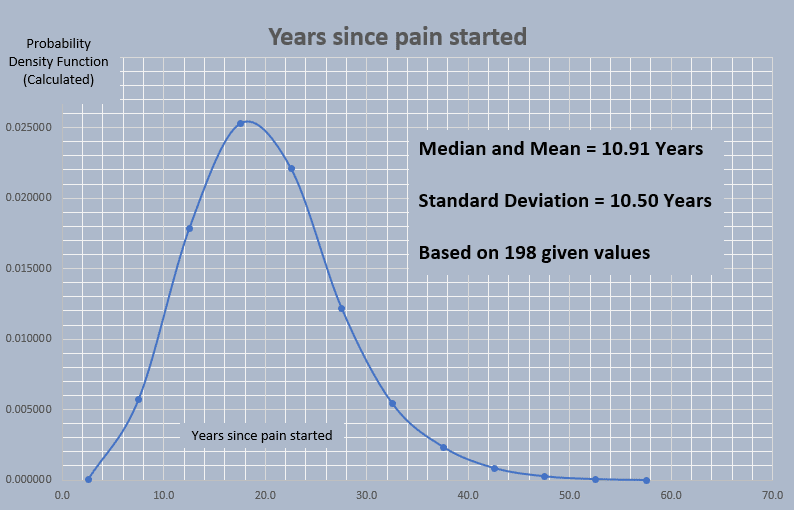
Why do we only have Anecdotal Evidence? A "Catch 22" issue!
Scientific medical studies are accompanied by high costs, typically funded by well-established pharmaceutical companies. These companies tend to invest in research projects with the anticipation of profiting from patented products. However, when it comes to talk therapies, such as OldPain2Go®, the inability to patent these approaches creates challenges in securing funding and obtaining scientific validation. Consequently, novel concepts might face dismissal from exploration by pain scientists due to it not already having established scientific evidence. This catch-22 situation poses a barrier to reaching a broader audience in need of potential solutions, hindering access to new ideas and concepts. Furthermore, without the scientific study, Health Authorities and Insurance Companies may not consider such approaches, despite their potential to significantly reduce costs and aid in a swift recovery.
Scientists often find themselves entrenched in a particular mindset, anticipating that solutions to intricate problems must be intricate themselves. Additionally, they may perceive that implementing these solutions will require lengthy time frames and intricate explanations tailored to individuals with diverse educational backgrounds. Consequently, they may not readily anticipate that individuals outside the scientific realm can arrive at effective and enduring solutions in concise, single sessions. These sessions can yield immediately noticeable outcomes that resonate with both practitioners and clients alike. That will of course seem beyond credibility by the scientific community.
In contrast to scientific studies that often evaluate pain in comparison to medication, which aims to minimize placebo effects, OldPain2Go® seeks to harness the potent placebo effect intentionally. This effect, well-documented in research, holds real significance. Additionally, the methodology strives to diminish or eliminate the nocebo effect by reframing the body's perception of pain as counterproductive. It challenges the notion that enduring pain is beneficial and encourages the release of such a mindset.
As an individual, I cannot afford to fund a full scientic study nor is OldPain2Go® a suitable candidate for randomisiation, or conducting blind or double-blind studies, where individuals are unaware of the treatment or receive alternative treatments, because it is not ethically, legally, or practically feasible for a therapist to trick clients, withold treatment or not be completely honest. Despite these limitations, exploring and documenting the impact of OldPain2Go® through qualitative self-reports and anecdotal evidence can still offer insights into its potential efficacy. This approach provides a means to gather valuable information without compromising ethical standards.
Awareness Notice:
As we rarely ask paying clients for an end of session feedback video, many of these videos are from short demonstrations that were demonstration taster sessions, given for free. In a "normal" Pain Review Session" more detailed investigation is carried out and the time needed varies with client and complexity, most are within an hour duration but a session can be longer. Hence the need to speak to a practitioner before booking anything.
As a mark of openness and for those who like to work with raw data here are the figures from the 216 Feedback Forms. Please note ref numbers are random and the data is not in date order.
Ref Number | Start SUD | Finish SUD | % Reduction |
1 | 6 | 0 | 100 |
2 | 4.5 | 1 | 78 |
3 | 7 | 1 | 86 |
4 | 8 | 0 | 100 |
5 | 6 | 0 | 100 |
6 | 4 | 0 | 100 |
7 | 9 | 1 | 89 |
8 | 5 | 2 | 60 |
9 | 9 | 0 | 100 |
10 | 5 | 0 | 100 |
11 | 5 | 0 | 100 |
12 | 6 | 0 | 100 |
13 | 7 | 0 | 100 |
14 | 5 | 0 | 100 |
15 | 5 | 0 | 100 |
16 | 6 | 0 | 100 |
17 | 8 | 0 | 100 |
18 | 9 | 0 | 100 |
19 | 4 | 0 | 100 |
20 | 5 | 0 | 100 |
21 | 8 | 1 | 88 |
22 | 5 | 0 | 100 |
23 | 6 | 0 | 100 |
24 | 10 | 0 | 100 |
25 | 10 | 0 | 100 |
26 | 8 | 0 | 100 |
27 | 5 | 0 | 100 |
28 | 4 | 0 | 100 |
29 | 9 | 0 | 100 |
30 | 9 | 2 | 78 |
31 | 8 | 0 | 100 |
32 | 8 | 0 | 100 |
33 | 6 | 0 | 100 |
34 | 6 | 0 | 100 |
35 | 8 | 3 | 63 |
36 | 6 | 1 | 83 |
37 | 4 | 1 | 75 |
38 | 8 | 0 | 100 |
39 | 7 | 0 | 100 |
40 | 10 | 1 | 90 |
41 | 6.5 | 0 | 100 |
42 | 10 | 0 | 100 |
43 | 3 | 0 | 100 |
44 | 7 | 0.5 | 93 |
45 | 9 | 1 | 89 |
46 | 5 | 0 | 100 |
47 | 5 | 0 | 100 |
48 | 8 | 0 | 100 |
49 | 6 | 1 | 83 |
50 | 6 | 1 | 83 |
51 | 6.5 | 0.5 | 92 |
52 | 8 | 0 | 100 |
53 | 4 | 0 | 100 |
54 | 7 | 0 | 100 |
55 | 3 | 0 | 100 |
56 | 7 | 2 | 71 |
57 | 10 | 0 | 100 |
58 | 5 | 0 | 100 |
59 | 3 | 0 | 100 |
60 | 5 | 2 | 60 |
61 | 7 | 0 | 100 |
62 | 7 | 2 | 71 |
63 | 7 | 2 | 71 |
64 | 3 | 0 | 100 |
65 | 8 | 0 | 100 |
66 | 2 | 0 | 100 |
67 | 3 | 0 | 100 |
68 | 7 | 1 | 86 |
69 | 6 | 0 | 100 |
70 | 3 | 1 | 67 |
71 | 10 | 0 | 100 |
72 | 3 | 0 | 100 |
73 | 6 | 1 | 83 |
74 | 9 | 0 | 100 |
75 | 5 | 0 | 100 |
76 | 4 | 0 | 100 |
77 | 4 | 0 | 100 |
78 | 4 | 1 | 75 |
79 | 6 | 0 | 100 |
80 | 4 | 0 | 100 |
81 | 4.5 | 0 | 100 |
82 | 7 | 0 | 100 |
83 | 5 | 0 | 100 |
84 | 6 | 0 | 100 |
85 | 4 | 0 | 100 |
86 | 5 | 0 | 100 |
87 | 8 | 1 | 88 |
88 | 7 | 1 | 86 |
89 | 6 | 0 | 100 |
90 | 6 | 1 | 83 |
91 | 5 | 0 | 100 |
92 | 5 | 0 | 100 |
93 | 7 | 0 | 100 |
94 | 7 | 0 | 100 |
95 | 5 | 0 | 100 |
96 | 10 | 0 | 100 |
97 | 7 | 2.5 | 64 |
98 | 5 | 1 | 80 |
99 | 7 | 0 | 100 |
100 | 8 | 2 | 75 |
101 | 4 | 0 | 100 |
102 | 8 | 2 | 75 |
103 | 8 | 3 | 63 |
104 | 8 | 0 | 100 |
105 | 7.5 | 0 | 100 |
106 | 7.5 | 0 | 100 |
107 | 6 | 0 | 100 |
108 | 5 | 0 | 100 |
109 | 9 | 0 | 100 |
110 | 7 | 1 | 86 |
111 | 9 | 1 | 89 |
112 | 6 | 0 | 100 |
113 | 8 | 1 | 88 |
114 | 3 | 0 | 100 |
115 | 3 | 0 | 100 |
116 | 6 | 0 | 100 |
117 | 10 | 0 | 100 |
118 | 9 | 0 | 100 |
119 | 5 | 1 | 80 |
120 | 7 | 0 | 100 |
121 | 4 | 0 | 100 |
122 | 6 | 0 | 100 |
123 | 4 | 0 | 100 |
124 | 7.5 | 0.5 | 93 |
125 | 4 | 0 | 100 |
126 | 6 | 1 | 83 |
127 | 4 | 0 | 100 |
128 | 6 | 0 | 100 |
129 | 3 | 0 | 100 |
130 | 8 | 0 | 100 |
131 | 7 | 0 | 100 |
132 | 6 | 0 | 100 |
133 | 4 | 0 | 100 |
134 | 4 | 0 | 100 |
135 | 10 | 0 | 100 |
136 | 7 | 0 | 100 |
137 | 4 | 0 | 100 |
138 | 2 | 0 | 100 |
139 | 7 | 0 | 100 |
140 | 7 | 0 | 100 |
141 | 6 | 0 | 100 |
142 | 7 | 0 | 100 |
143 | 7 | 0 | 100 |
144 | 8 | 0 | 100 |
145 | 3 | 0 | 100 |
146 | 4 | 0 | 100 |
147 | 3.5 | 0 | 100 |
148 | 6 | 0 | 100 |
149 | 5 | 1 | 80 |
150 | 5 | 0 | 100 |
151 | 6 | 0 | 100 |
152 | 6 | 0 | 100 |
153 | 4.5 | 0 | 100 |
154 | 10 | 0 | 100 |
155 | 7 | 5 | 29 |
156 | 6 | 0 | 100 |
157 | 7 | 0 | 100 |
158 | 8 | 2 | 75 |
159 | 8 | 0 | 100 |
160 | 5 | 0 | 100 |
161 | 8 | 0 | 100 |
162 | 3.5 | 0 | 100 |
163 | 4 | 0 | 100 |
164 | 8 | 0 | 100 |
165 | 7 | 2 | 71 |
166 | 7 | 0 | 100 |
167 | 3 | 1 | 67 |
168 | 4.5 | 0 | 100 |
169 | 2 | 0 | 100 |
170 | 5 | 0 | 100 |
171 | 6 | 0 | 100 |
172 | 7 | 0 | 100 |
173 | 4 | 0 | 100 |
174 | 8 | 0 | 100 |
175 | 6 | 0 | 100 |
176 | 7 | 0 | 100 |
177 | 3 | 0 | 100 |
178 | 5 | 0 | 100 |
179 | 3 | 0 | 100 |
180 | 7 | 2 | 71 |
181 | 4 | 0 | 100 |
182 | 3 | 0 | 100 |
183 | 8 | 0 | 100 |
184 | 10 | 0 | 100 |
185 | 6 | 0 | 100 |
186 | 5 | 3 | 40 |
187 | 3.5 | 0 | 100 |
188 | 9 | 0 | 100 |
189 | 8 | 0 | 100 |
190 | 5 | 0 | 100 |
191 | 3 | 0 | 100 |
192 | 5 | 0 | 100 |
193 | 8 | 0 | 100 |
194 | 8 | 0 | 100 |
195 | 3 | 0 | 100 |
196 | 8 | 2 | 75 |
197 | 8 | 0 | 100 |
198 | 9 | 5 | 44 |
199 | 5 | 0 | 100 |
200 | 6 | 0 | 100 |
201 | 3.5 | 0 | 100 |
202 | 7.5 | 0 | 100 |
203 | 5 | 0 | 100 |
204 | 6 | 3 | 50 |
205 | 8 | 0 | 100 |
206 | 4 | 0 | 100 |
207 | 10 | 0 | 100 |
208 | 7 | 0 | 100 |
209 | 6 | 1 | 83 |
210 | 8 | 0 | 100 |
211 | 8 | 0 | 100 |
212 | 8 | 0 | 100 |
213 | 5 | 1 | 80 |
214 | 5 | 0 | 100 |
215 | 2 | 0 | 100 |
216 | 3.5 | 0 | 100 |

